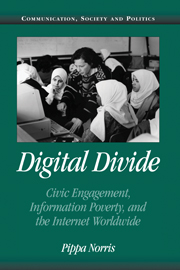Book contents
- Frontmatter
- Contents
- List of Tables
- List of Figures
- Preface
- PART I INTRODUCTORY FRAMEWORK
- PART II THE VIRTUAL POLITICAL SYSTEM
- PART III THE DEMOCRATIC DIVIDE
- 10 Cyberculture
- 11 Civic Engagement
- 12 Conclusions: Promoting e-Democracy
- Appendix A Nations in the Study and Abbreviated Names Used in Figures
- Notes
- Select Bibliography
- Index
10 - Cyberculture
Published online by Cambridge University Press: 05 June 2012
- Frontmatter
- Contents
- List of Tables
- List of Figures
- Preface
- PART I INTRODUCTORY FRAMEWORK
- PART II THE VIRTUAL POLITICAL SYSTEM
- PART III THE DEMOCRATIC DIVIDE
- 10 Cyberculture
- 11 Civic Engagement
- 12 Conclusions: Promoting e-Democracy
- Appendix A Nations in the Study and Abbreviated Names Used in Figures
- Notes
- Select Bibliography
- Index
Summary
Previous chapters have examined the way that the political system has responded to the new structure of opportunities for information and communication that have become available via the Internet. To summarize developments, the evidence presented in earlier chapters demonstrates how far political websites have flourished and multiplied in cyberspace: In 179 countries around the globe, today almost 100 parliaments can be found online, along with 1,250 parliamentary parties, 14,500 governments departments, 2,500 newspapers, 12,000 news sites, and more than 12,000 groups and new social movements. This process can only be expected to continue, given the wider spread of Internet access and use among the public. To assess how much these developments will influence the democratic process we need to determine how ordinary citizens have responded to the new opportunities for civic engagement in the virtual world.
Digital technologies could influence mass public opinion in different ways, and this process can be understood using the fourfold schema illustrated in Figure 10.1. As discussed in the next chapter, the participation hypothesis holds that the opportunities for information, networking, and communication via digital technologies might affect patterns of civic engagement, either reinforcing those citizens who are already most active through traditional channels, or mobilizing new participants who are currently disengaged from the political process; for example, by energizing younger voters who pay little attention to newspapers and TV news, or by stimulating community activists.
- Type
- Chapter
- Information
- Digital DivideCivic Engagement, Information Poverty, and the Internet Worldwide, pp. 195 - 216Publisher: Cambridge University PressPrint publication year: 2001
- 1
- Cited by

